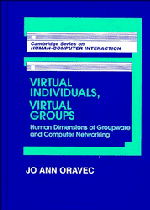Book contents
- Frontmatter
- Contents
- Dedication
- Overview
- Introduction
- 1 Evolution of computer application genres: Groupware and other network-based system applications
- 2 On the infinite variety of virtual entities
- 3 The shape of groups to come: Efforts to define, label, explain, and model collaborative activity
- 4 Shared resources and spaces: Lessons from the use of desks, tables, whiteboards, office settings, and video
- 5 Cultural objects and technological dreams: Dependence, autonomy, and intellectual augmentation
- 6 Privacy, anonymity, and agency: Applications of computer networking and the development of social analogues
- 7 Toward a genre-responsive design approach for computing applications
- Bibliography
- Author index
- Subject index
6 - Privacy, anonymity, and agency: Applications of computer networking and the development of social analogues
Published online by Cambridge University Press: 05 August 2011
- Frontmatter
- Contents
- Dedication
- Overview
- Introduction
- 1 Evolution of computer application genres: Groupware and other network-based system applications
- 2 On the infinite variety of virtual entities
- 3 The shape of groups to come: Efforts to define, label, explain, and model collaborative activity
- 4 Shared resources and spaces: Lessons from the use of desks, tables, whiteboards, office settings, and video
- 5 Cultural objects and technological dreams: Dependence, autonomy, and intellectual augmentation
- 6 Privacy, anonymity, and agency: Applications of computer networking and the development of social analogues
- 7 Toward a genre-responsive design approach for computing applications
- Bibliography
- Author index
- Subject index
Summary
Overconcern for privacy may indicate retreat from responsibility and sagging motivation.
Propst (1968, p. 2)Half the world today is engaged in keeping the other half “under surveillance.”
McLuhan and Nevitt (1972)What can “privacy,” “anonymity,” or “agency” mean for members of a collaborative workgroup? The presumption that groups are supposed to work together in harmony and close contact may seem to exclude the need for private spaces, the opportunity to make an anonymous contribution, or the capacity to have one's work done by an agent or surrogate. However, these cultural objects have served to shape CSCW and other network-based system applications.
Privacy, anonymity, and agency in the realm of the societal construction of computing applications have a number of common denominators. Each has special associations within the group level: individuals’ expectations for privacy, or the meanings they attach to a statement delivered under the cloak of anonymity, are affected by whether or not they are working in a group or team context. Roles that agents play in computing applications are also sensitive to group context; for instance, groups may set standards for the kinds of activities in which they can be utilized.
These three cultural objects have also been topics of frequent discussion within computer application design communities. “Social analogues,” system features that are intentionally linked by developers to specific cultural objects, have been formulated for each of the three. The question of whether a social analogue will be successful in maintaining a strong linkage with a certain cultural object (beyond the association that designers have attempted to make) has a number of complex dimensions.
- Type
- Chapter
- Information
- Virtual Individuals, Virtual GroupsHuman Dimensions of Groupware and Computer Networking, pp. 223 - 275Publisher: Cambridge University PressPrint publication year: 1996



